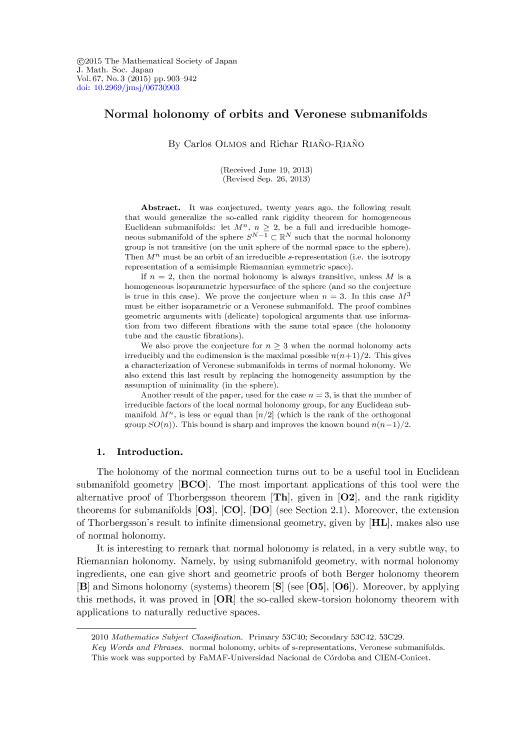Mostrar el registro sencillo del ítem
dc.contributor.author
Olmos, Carlos Enrique

dc.contributor.author
Riaño Riaño, Richar Fernando

dc.date.available
2018-07-11T19:00:25Z
dc.date.issued
2015-06
dc.identifier.citation
Olmos, Carlos Enrique; Riaño Riaño, Richar Fernando; Normal holonomy of orbits and Veronese submanifolds; Math Soc Japan; Journal Of The Mathematical Society Of Japan; 67; 3; 6-2015; 903-942
dc.identifier.issn
0025-5645
dc.identifier.uri
http://hdl.handle.net/11336/51759
dc.description.abstract
It was conjectured, twenty years ago, the following result that would generalize the so-called rank rigidity theorem for homogeneous Euclidean submanifolds: let Mn, n≥2, be a full and irreducible homogeneous submanifold of the sphere SN-1⊂ ℝ N such that the normal holonomy group is not transitive (on the unit sphere of the normal space to the sphere). Then Mn must be an orbit of an irreducible s-representation (i.e. the isotropy representation of a semisimple Riemannian symmetric space). If n = 2, then the normal holonomy is always transitive, unless M is a homogeneous isoparametric hypersurface of the sphere (and so the conjecture is true in this case). We prove the conjecture when n = 3. In this case M3 must be either isoparametric or a Veronese submanifold. The proof combines geometric arguments with (delicate) topological arguments that use information from two different fibrations with the same total space (the holonomy tube and the caustic fibrations). We also prove the conjecture for n ≥3 when the normal holonomy acts irreducibly and the codimension is the maximal possible n(n+1)=2. This gives a characterization of Veronese submanifolds in terms of normal holonomy. We also extend this last result by replacing the homogeneity assumption by the assumption of minimality (in the sphere). Another result of the paper, used for the case n = 3, is that the number of irreducible factors of the local normal holonomy group, for any Euclidean submanifold Mn, is less or equal than [n=2] (which is the rank of the orthogonal group SO(n)). This bound is sharp and improves the known bound n(n-1)/2.
dc.format
application/pdf
dc.language.iso
eng
dc.publisher
Math Soc Japan

dc.rights
info:eu-repo/semantics/openAccess
dc.rights.uri
https://creativecommons.org/licenses/by-nc-sa/2.5/ar/
dc.subject
Normal Holonomy
dc.subject
Orbits of S-Representations
dc.subject
Veronese Submanifolds
dc.subject.classification
Matemática Pura

dc.subject.classification
Matemáticas

dc.subject.classification
CIENCIAS NATURALES Y EXACTAS

dc.title
Normal holonomy of orbits and Veronese submanifolds
dc.type
info:eu-repo/semantics/article
dc.type
info:ar-repo/semantics/artículo
dc.type
info:eu-repo/semantics/publishedVersion
dc.date.updated
2018-07-04T19:19:25Z
dc.journal.volume
67
dc.journal.number
3
dc.journal.pagination
903-942
dc.journal.pais
Japón

dc.journal.ciudad
Tokyo
dc.description.fil
Fil: Olmos, Carlos Enrique. Consejo Nacional de Investigaciones Científicas y Técnicas. Centro Científico Tecnológico Conicet - Córdoba. Centro de Investigación y Estudios de Matemática. Universidad Nacional de Córdoba. Centro de Investigación y Estudios de Matemática; Argentina
dc.description.fil
Fil: Riaño Riaño, Richar Fernando. Universidad de los Andes; Colombia. Consejo Nacional de Investigaciones Científicas y Técnicas. Centro Científico Tecnológico Conicet - Córdoba. Centro de Investigación y Estudios de Matemática. Universidad Nacional de Córdoba. Centro de Investigación y Estudios de Matemática; Argentina
dc.journal.title
Journal Of The Mathematical Society Of Japan

dc.relation.alternativeid
info:eu-repo/semantics/altIdentifier/url/https://projecteuclid.org/euclid.jmsj/1438777435
dc.relation.alternativeid
info:eu-repo/semantics/altIdentifier/doi/http://dx.doi.org/10.2969/jmsj/06730903
Archivos asociados
